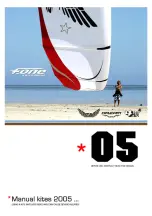
Puma 13.5
Owner’s Manual
14. Please note the
VB
must be fully off. It should not be pulled on if the glider is laid flat on the ground.
To do so could over tension the side wires, bend the tangs, stretch the speed bar etc. The glider should be
stood on its control frame before operation of the VB is checked.
15. Make sure that the wires are not twisted, then stand the glider on its control frame and attach the swan
catch, pip pin and safety washer.
16. Make sure that the nose catch is correctly attached and then put the nose cone on.
Note: Never hook in nose catch without pip pin inserted, even as a temporary measure while
rigging, forgetting to insert the pip pin could have disastrous consequences!
17. If flying with wing tip fairing they should now be fitted: Put the tip inside the sail and attach the top
Velcro. Lift the trailing edge of the wing tip slightly until the under-surface is as tight as it will be in
flight. Velcro the lower surface to the tip fairing. When the trailing edge is released there may be some
looseness at the front of the under-surface at the tip. This looseness will disappear in flight. Check for
symmetry of fitting of both wing tip fairings.
18. The glider is now fully rigged. You should now make sure that you do a thorough pre-flight check before
you fly, making particular care that all undersurface zips (4 washout rods and central undersurface) are
closed.
19. We suggest that if there is significant wind that the glider is left flat on the ground, nose into wind and
securely weighted or tied down at the nose until you are ready to fly. In light winds the Puma may be left
standing on its 'A' frame tail into wind- but be wary of gusts of wind, thermals and dust devils. Keep a
close eye on it.
Rigging on the A-frame
1. This is useful in confined spaces or where the terrain is likely to cause soiling or damage to the sail.
2. Lay the glider on the ground. If there is any wind the nose should be pointing cross or down wind. Unzip
the bag and take off enough ties to remove the battens and assemble the A frame.
3. The nose batten should already be in the sail. Move its front end onto its plastic location at the front of
the keel.
4. Assemble the A frame. Put the bottom bar on and insert the two stainless pins from the back of the base
bar and fit the safety rings.PUT THE RINGS IN IMMEDIATELY. DO NOT LEAVE IT UNTIL
LATER. Thread the VB cord through cleat on the base bar. Tie a 'stop' knot 5cm from the end of the VB
cord.
5. Stand the glider on its A-frame. Take the bag and remaining ties off and remove the battens from the top
of the wing. Check that the glider is positioned correctly relative to any wind and that it can be secured in
its current location when fully rigged. (i.e. glider should be facing with 'back' to the wind)
6. Making sure that the wires are not kinked, attach the nose swan catch, pip pin and safety cap.
7. Remove the last of the ties and open the wings slightly. Walk the wings out to about three quarters of
their full extension. As before the wings should ideally be walked out together. If you are rigging by
yourself move alternate wings gradually apart.
Please note:
Whilst spreading the wings, particularly when the glider is standing on its A frame, it is essential that the
leading edges and keel are kept in the same plane. (This is to avoid distortion to the nose plates or any
other components.)
8. Take care to place the tips on a piece of ground that is not likely to cause them damage. Leave the tip
socks on as this will protect them. The glider should now be standing on its A frame, wing tips and keel.
9. Push the tip socks down the leading edge so some more of the sail is released but leave the sock at the
end to protect the sail.
Puma 13.5 hand book-Rev-02
8
Summary of Contents for PUMA 13.5
Page 1: ...PUMA 13 5...
Page 21: ...Puma 13 5 Owner s Manual Figure 4 Checking batten tension Puma 13 5 hand book Rev 02 21...
Page 38: ...Puma 13 5 Owner s Manual Section 3 Assembly Drawings Puma 13 5 hand book Rev 02 38...
Page 39: ...Puma 13 5 Owner s Manual NOSE ASSEMBLY Figure 10 Nose assembly Puma 13 5 hand book Rev 02 39...









































